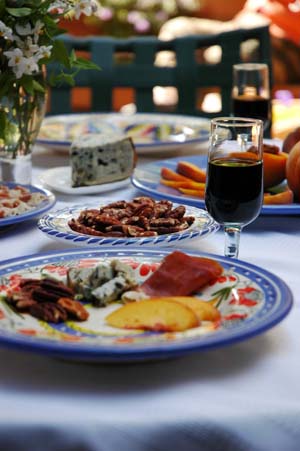

The Cheese
Cabrales (ka-BRAH’-lays) and picon (pee-KONE”) are blue cheeses made in adjoining regions on the North Coast of Spain, and are almost indistinguishable from each other. Cabrales is always made from a mix of cow, sheep and goat milks, while Picon is occasionally made from strictly cow’s milk. Nonetheless, these cheeses are more similar than different.
One defining characteristic is the vibrant strain of mold induced into these cheeses. While Gorgonzola is quite greenish, and even Roquefort has a somewhat greenish cast to its characteristic blue mold, these Spanish cheeses boast a mold so deep indigo it is almost purple.
Not as salty or sticky as Roquefort, these cheeses are often wrapped in large leaves (typically oak, sycamore or maple) and foil prior to shipment from the factory. The finest cheeses are produced from spring and summer unpasteurized milk and aged 3-6 months, so the best time to buy them is fall and early winter.
Cabrales and picon are visually striking, but that is only the beginning of their appeal. Potent and richly complex, they are not for the faint of heart. With flavors as diverse as currants, huckleberry, dark chocolate, mown hay and beef roast, these cheeses require serious attention from the taster to unravel the multiple layers of flavor.
The Wine
Sherry is so misunderstood in this country, I almost hesitate to include it in tastings. When Americans think of sherry, most envision a sickly sweet, brownish liquor with few redeeming qualities, better suited to the urban wino than a sophisticated cheese pairing. The truth could not be farther from that perception.
–
Available in a wide range of styles and sweetness, sherry is one of the greatest beverages in the world. Most all sherries fall into two basic types; fino and oloroso. The difference is in the way the wines are aged. All sherry is aged in barrels filled only about 5/6 full, allowing for air in the barrel.
In oloroso wines, the surface of the Sherry is open the air, inducing oxidation, which turns the golden-hued wine deeper mahogany and develops the nutty-raisiny flavors associated with these wines. Most olorosos are long-aged and fermented dry, but a few versions (amoroso and the ubiquitous cream sherry) are sweetened.
Fino sherries employ a strain of yeast called flor to create a thick layer on top of the wine, slowing or eliminating oxidation. This creates a light-hued, subtly flavored wine, typically bone-dry, with a decided tang from the flor. Unlike olorosos, finos are best enjoyed young, and are rarely aged beyond a few years. One major exception is amontillado. This fino is aged until the flor dies off (about 6 years) and the wine begins to oxidize, imparting deeper color and rich nuttiness to the wine.
There are many more styles, but this gives you a good start. For today’s tasting, try to find an amoroso (sweetened oloroso) version, at least 10 years old.
The Extras
This pair can be accompanied by a variety of fruits (stone fruits like peaches, nectarines, apricots and cherries are my favorites) and rich, meaty nuts such as walnuts, pecans and macadamias. Cured meats are also appropriate. Spanish hams (jamon) are legendary, from the readily-available Serrano to the hard-to find (but worth the effort!) Jabugo.
Why it Works
Blues and dessert wines or fortified wines are a common pairing all around Europe. In France, roquefort and sauterne is legendary. In England, the tradition of stilton and port dates back centuries. These pairings are the quintessential example of the sweet/salty flavor experience. By adding the fruits, nuts and meats, you add multiple layers of flavors and textures. But the backbone is the interplay between the sweetness of this wine and the saltiness of any blue cheese.


